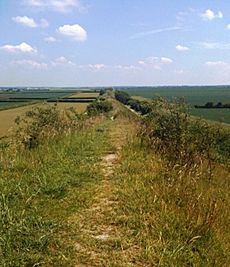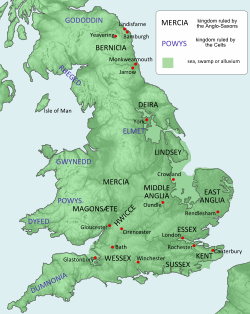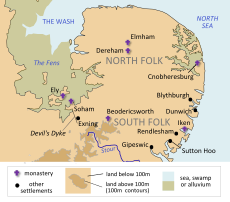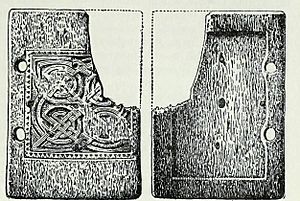Anna of East Anglia facts for kids
Quick facts for kids Anna |
|
|---|---|

Marshland around Blythburgh, near where Anna met his death
|
|
| King of the East Angles | |
| Reign | c. 636 – 654 AD |
| Predecessor | Ecgric |
| Successor | Æthelhere |
| Died | 653 or 654 AD Battle of Bulcamp |
| Burial | probably Blythburgh, Suffolk, now lost |
| Consort | Sæwara |
| Issue | Jurmin Seaxburh Æthelthryth Æthelburh possibly Wihtburh |
| House | Wuffingas |
| Father | Eni |
| Religion | Christian |
Anna (also known as Onna) was a king of East Anglia who ruled from the early 640s until his death in 653 or 654 AD. He belonged to the Wuffingas family, which was the ruling family of the East Angles. Anna was one of three sons of Eni who became king.
He became king after Ecgric was killed in battle by Penda of Mercia. A famous historian named Bede praised Anna for his strong Christian faith. Anna was also known for his very religious family. His son, Jurmin, and all his daughters – Seaxburh, Æthelthryth, Æthelburh, and possibly Wihtburh – were all made saints.
We don't know much about Anna's life or his time as king because very few records from that period have survived. In 645, Cenwalh of Wessex was forced out of his kingdom by King Penda. Anna helped Cenwalh, and while Cenwalh was staying with Anna, he became a Christian. When Cenwalh returned to his own kingdom, he brought Christianity back with him, and the people of Wessex remained Christian.
Around 651, the area around the Isle of Ely became part of East Anglia. This happened after Anna's daughter, Æthelthryth, got married. Anna also gave a lot of money and gifts to a monastery near the coast called Cnobheresburg. In 651, after an attack by Penda on Cnobheresburg, Anna had to leave his kingdom. He might have gone to the western kingdom of the Magonsæte.
Anna came back to East Anglia around 653. But soon after, Penda attacked again. Anna led the East Anglian army, but they were defeated by the Mercians at the Battle of Bulcamp. Both Anna and his son Jurmin were killed in this battle. Anna's brother, Æthelhere, became the next king. After Anna's reign, East Anglia became less powerful compared to its strong neighbor, Mercia.
Contents
Early Life and Family
Anna was the son of Eni, who was part of the Wuffingas royal family. His uncle, Rædwald, was king of the East Angles from 600 to 625. The Kingdom of East Anglia was an early Anglo-Saxon kingdom. It had a northern part (now Norfolk) and a southern part (now Suffolk).
Anna was married, and his wife's name was Sæwara. The historian Bede mentions a saint named Sæthryth as the "daughter of the wife of Anna." Some historians believe Sæwara was Anna's wife.
In 631, Anna was likely in a village called Exning in Suffolk. This was an important place with royal connections. It's believed that his daughter, Æthelthryth, was born there. Tradition says Æthelthryth was baptized at a pool in Exning called St Mindred's Well. Exning was important because it was near the Devil's Dyke. This was a large earth wall built long ago to protect East Anglia from attacks.
Becoming King of the East Angles
Anna's Rise to Power
Around 632 or 633, Edwin of Northumbria, a powerful Christian king, was defeated and killed. His kingdom was attacked by Cadwallon ap Cadfan and Penda of Mercia. Penda then turned his attention to East Anglia. At some point, possibly in the early 640s, Penda's army defeated the East Anglians. King Ecgric and his earlier predecessor, Sigeberht, were both killed.
After this defeat, Anna became king of the East Angles. The exact date is not clear, but it was likely in the early 640s. Anna probably became king with help from the northern Angles. During his rule, he faced many attacks from Penda of Mercia. Mercia and East Anglia were often enemies because they both wanted control over the Middle Angles.
Alliances and Religious Life
Anna made an important alliance by arranging for his daughter, Seaxburh, to marry Eorcenberht of Kent, the king of Kent. This helped connect the two kingdoms. Not all of Anna's daughters married into other royal families. In the 640s, Anna's daughter Æthelburg and his stepdaughter Sæthryth went to Faremoutiers Abbey in Gaul (modern France). They chose to live religious lives as nuns. They were the first Anglo-Saxon princesses to become nuns. This made living a religious life a respected choice for royal women.
Historians believe that Anna's kingdom had strong ties with the Franks in Gaul. This connection had started with his predecessor, Sigeberht, who had lived in Gaul as an exile and became a devout Christian.
In 641, Oswald of Northumbria was killed in battle by Penda. After Oswald's death, Northumbria was divided. In 645, King Penda drove Cenwalh of Wessex from his kingdom. Cenwalh found safety at Anna's court. While he was a refugee there, he became a Christian. In 648, Cenwalh returned to rule Wessex as a Christian king. Anna likely helped Cenwalh get his throne back.
Anna also strengthened his control over the western parts of his kingdom. This area bordered the Fen lands around the Isle of Ely. He did this by arranging for his daughter, Æthelthryth, to marry Tondberht in 651. Tondberht was a prince of the South Gyrwas, a people who lived in the Fens.
Forced to Leave
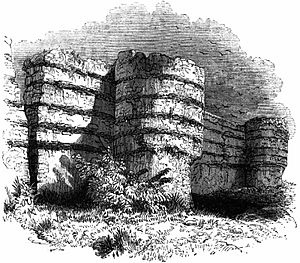
During his reign, Anna gave many rich gifts to the monastery at Cnobheresburg. This monastery was built around 633 by a monk named Fursey. Over time, Fursey became tired of the attacks on the kingdom. He left East Anglia, leaving the monastery to his brother, Foillan.
In 651, Penda attacked the monastery. Anna and his soldiers fought back, holding off the Mercians. This gave Foillan and his monks time to escape with their books and valuable items. But Penda defeated Anna and forced him to leave his kingdom. Anna might have gone to the kingdom of Merewalh in western Shropshire. He returned to East Anglia around 654.
Death and Legacy
Soon after 653, Penda attacked East Anglia again. The armies of Penda and Anna met at Bulcamp, near Blythburgh in Suffolk. The East Anglians were defeated, and many were killed. King Anna and his son, Jurmin, both died in this battle. The Anglo-Saxon Chronicle mentions Anna's death in the entry for 653 or 654.
Blythburgh, which is about a mile from Bulcamp, was later believed to be the burial place of Anna and Jurmin. It might have been a monastery or a royal estate. An old writing-tablet made of whalebone, used for religious purposes, was found near the site.
Saint Botolph began building his monastery at Icanho (now Iken, Suffolk) in the same year Anna was killed. This might have been to honor the king. Anna's two brothers, Æthelhere and Æthelwold, became kings after him. It's possible that Æthelhere was a puppet ruler for Penda or his ally. Æthelhere was killed in battle in 655 or 656. After Æthelhere and Æthelwold, Anna's youngest brother's descendants became kings.
Bede praised Anna's strong faith in his book, Ecclesiastical History of the English People. Modern historians also see Anna as a very religious king. His reputation as a devoted Christian is mainly because his son and four daughters all became Anglo-Saxon saints. Even 500 years after his death, people still honored his tomb at Blythburgh.
Anna's Family
All of Anna's known children became saints.
- His oldest daughter, Seaxburh, was married to Eorcenberht of Kent. She ruled Kent from 664 until her son, Ecgberht, was old enough to rule.
- Æthelthryth, another daughter, founded the monastery at Ely in 673.
- His daughter, Æthelburh, spent her life as a nun at the Faremoutiers nunnery.
- Anna's son, Jurmin, was a warrior. He was killed in battle in 653.
Anna is also traditionally said to have had a fourth daughter named Wihtburh. She was an abbess at Dereham. However, Bede does not mention her. She first appears in a calendar from the late 10th century. Some historians think she might have been a character created by the religious community at Ely. They might have used her story to show that a saint's body could remain whole after death.
| Family of Anna of East Anglia | ||||||||||||||||||||||||||||||||||||||||||||||||||||||||||||||||||||||||||||||||||||||||||||||||||||||||||||||||||||||||||||||||||||||||||||||||||||||||||||||||||||||||||||||||||||||||||||||||||||||||||||||||||||||||||||||||||||||||||||||||||||||||||||||||||||||||||||||||||||||||||||||||||||||||||||||||||||||||||||||||||||||||||||||||||||||||||||||||||||||||||||||||||||||||||||||||||||||||||||||||||||||||||||||||||||||||||||||||||||||||||||||||||||||||||||||||||||||||||||||||||||||||||||||||||||||||||||||||||||||||||||||||||||||||||||||||||||||||||||||||||||||||||||||||||||||||||||||||||||||||||||||||||||||||||||||||||||||||||||||||||||||||||||||
|---|---|---|---|---|---|---|---|---|---|---|---|---|---|---|---|---|---|---|---|---|---|---|---|---|---|---|---|---|---|---|---|---|---|---|---|---|---|---|---|---|---|---|---|---|---|---|---|---|---|---|---|---|---|---|---|---|---|---|---|---|---|---|---|---|---|---|---|---|---|---|---|---|---|---|---|---|---|---|---|---|---|---|---|---|---|---|---|---|---|---|---|---|---|---|---|---|---|---|---|---|---|---|---|---|---|---|---|---|---|---|---|---|---|---|---|---|---|---|---|---|---|---|---|---|---|---|---|---|---|---|---|---|---|---|---|---|---|---|---|---|---|---|---|---|---|---|---|---|---|---|---|---|---|---|---|---|---|---|---|---|---|---|---|---|---|---|---|---|---|---|---|---|---|---|---|---|---|---|---|---|---|---|---|---|---|---|---|---|---|---|---|---|---|---|---|---|---|---|---|---|---|---|---|---|---|---|---|---|---|---|---|---|---|---|---|---|---|---|---|---|---|---|---|---|---|---|---|---|---|---|---|---|---|---|---|---|---|---|---|---|---|---|---|---|---|---|---|---|---|---|---|---|---|---|---|---|---|---|---|---|---|---|---|---|---|---|---|---|---|---|---|---|---|---|---|---|---|---|---|---|---|---|---|---|---|---|---|---|---|---|---|---|---|---|---|---|---|---|---|---|---|---|---|---|---|---|---|---|---|---|---|---|---|---|---|---|---|---|---|---|---|---|---|---|---|---|---|---|---|---|---|---|---|---|---|---|---|---|---|---|---|---|---|---|---|---|---|---|---|---|---|---|---|---|---|---|---|---|---|---|---|---|---|---|---|---|---|---|---|---|---|---|---|---|---|---|---|---|---|---|---|---|---|---|---|---|---|---|---|---|---|---|---|---|---|---|---|---|---|---|---|---|---|---|---|---|---|---|---|---|---|---|---|---|---|---|---|---|---|---|---|---|---|---|---|---|---|---|---|---|---|---|---|---|---|---|---|---|---|---|---|---|---|---|---|---|---|---|---|---|---|---|---|---|---|---|---|---|---|---|---|---|---|---|---|---|---|---|---|---|---|---|---|---|---|---|---|---|---|---|---|---|---|---|---|---|---|---|---|---|---|---|---|---|---|---|---|---|---|---|---|---|---|---|---|---|---|---|---|---|---|---|---|---|---|---|---|---|---|---|---|---|---|---|---|---|---|---|---|---|---|---|---|---|---|---|---|---|---|---|---|---|---|---|---|---|---|---|---|---|---|---|---|---|---|---|---|---|---|---|---|---|---|---|---|---|---|---|---|---|---|---|---|---|---|---|---|---|---|---|---|---|---|---|---|---|---|---|---|---|---|---|---|---|---|---|---|---|---|---|---|---|---|---|---|---|---|---|---|---|---|---|---|---|---|---|---|---|---|---|---|---|---|---|---|---|---|---|---|---|---|---|---|---|---|---|---|---|---|---|---|---|---|---|---|---|---|---|---|---|---|---|---|---|
|
||||||||||||||||||||||||||||||||||||||||||||||||||||||||||||||||||||||||||||||||||||||||||||||||||||||||||||||||||||||||||||||||||||||||||||||||||||||||||||||||||||||||||||||||||||||||||||||||||||||||||||||||||||||||||||||||||||||||||||||||||||||||||||||||||||||||||||||||||||||||||||||||||||||||||||||||||||||||||||||||||||||||||||||||||||||||||||||||||||||||||||||||||||||||||||||||||||||||||||||||||||||||||||||||||||||||||||||||||||||||||||||||||||||||||||||||||||||||||||||||||||||||||||||||||||||||||||||||||||||||||||||||||||||||||||||||||||||||||||||||||||||||||||||||||||||||||||||||||||||||||||||||||||||||||||||||||||||||||||||||||||||||||||||


